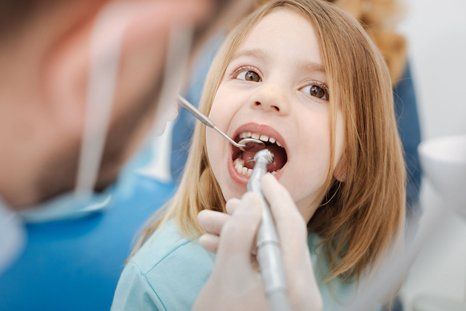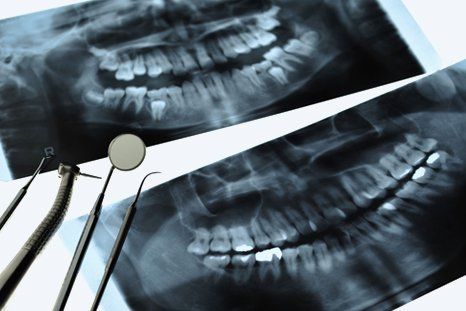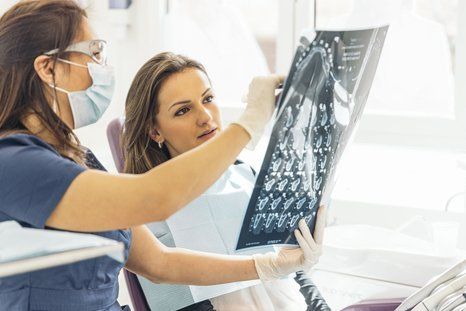Prepare for Your First Visit
Preparing for Your Child's Initial Visit
As more and more preschool children are showing up with cavities, the American Academy of Pediatrics suggests that dental visits begin when your child is one year old.
During your first visit, we will determine your child's cavity risk and help you learn how to manage diet, hygiene, and fluoride in their early years.
For more information, check out this website
on oral care for kids.

Why We Need to Take Dental X-Rays
Like many of our patients, you may wonder why we need dental X-rays and whether they are harmful. The fact is that X-rays tell us a lot about your dental health.
They expose hidden dental decay and can reveal dental abscesses, as well as a host of other problems.
- Impacted or extra teeth
- The condition of fillings, crowns, bridges, and root canals
- Bone loss from gum disease
- Foreign bodies within the gums or bone
X-rays also help us see if there is enough bone left in your jaw to hold dental implants.

Learn More About the Uses of X-Rays
To better understand dental X-ray radiation, please read this essay by Steve D. Rima, CHP.
Just the mention of the word “radiation” conjures up an unpleasant image for most people. We associate it with bombs, cancer, and all manner of other bad things. But do you know that there are many beneficial uses of radiation? One type of radiation, X-ray, is used extensively in the medical and dental professions to diagnose and treat a wide variety of conditions.
Just how much radiation do you get from a dental X-ray and how harmful is it? First, let’s talk about what an X-ray is. X-rays are energy in the form of waves, identical to visible light. In fact, the only difference between light and X-rays is that light doesn’t have enough energy to go through your body and X-rays do. Both can make an image on photographic film, so both types of energy are used to make pictures; light makes photographs of the “outside” of objects, X-rays make pictures of the “inside” of objects, including your body.
A unit called a “rem” is used to measure radiation. A rem is a large unit, much like a mile is a large unit of length, so we usually use a millirem (mrem) instead, much as you would measure in inches instead of miles for most purposes. (It takes 1000 mrem to equal one rem.)
Advances in X-ray equipment, especially film technology, allow your dentist to get a good X-ray image using much less radiation than was previously required. A typical dental X-ray image exposes you to only about 2 or 3 mrem. The National Council on Radiation Protection (NCRP) says that the average resident of the U.S. receives about 360 mrem every year from background sources. This comes from outer space, radioactive materials in the earth, and small amounts of radioactive material in most foods we consume.
Some typical sources that may expose you to radiation also include smoke detectors (less than 1 mrem per year), living in a brick house instead of a wood one (about 10 mrem per year due to radioactive materials in the masonry), cooking with natural gas (about 10 mrem per year from radon gas in the natural gas supply), reading a book for 3 hours per day (about 1 mrem per year due to small amounts of radioactive materials in the wood used to make the paper), and even from flying in an airplane (about 5 mrem for one cross-country flight because of the increased altitude.) In fact, you receive about 2 mrem per year from sleeping next to someone! This is because all of us have very small amounts of naturally occurring radioactive materials in our bodies.
Obviously, you probably would not refuse to fly on an airplane, live in a brick house, read books, live without smoke detectors, or sleep with your spouse because of the small amount of radiation you receive from these activities. Since your dentist gains valuable information from X-rays to aid you in keeping healthy teeth, it is also not in your best interest to refuse dental X-rays because of the very small amount of radiation you receive from them.
Steven D. Rima is a Board Certified Health Physicist with over 20 years of experience in radiation safety, including teaching medical and dental professionals for state licensure to take medical and dental X-rays.

Ask Us About the Use of Fluoride
If you have questions about the efficacy of fluoride, please read the American Dental Association's facts on fluoridation
and review evidence-based clinical practice guidelines related to fluoride and fluoridation.
You also may want to visit the websites of the Centers for Disease Control and Prevention
and the American Academy of Pediatrics' Campaign for Dental Health.
For more information or to request an appointment, call us now at 989-344-2525 or visit our office at 800 E Michigan Ave. Emergency Appointments Available. Please contact us today to Schedule.

